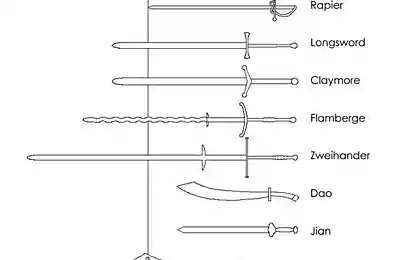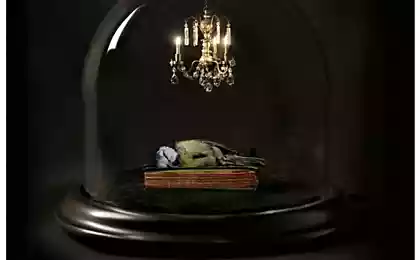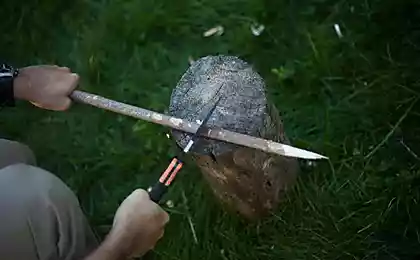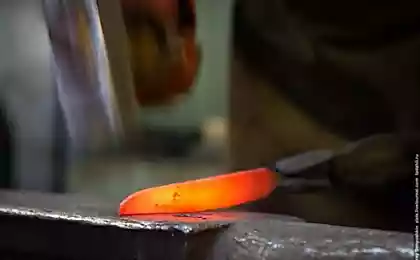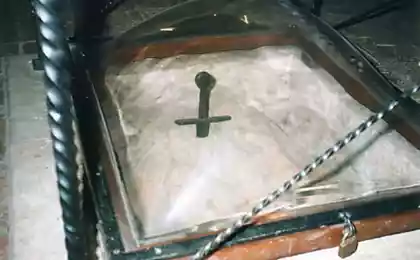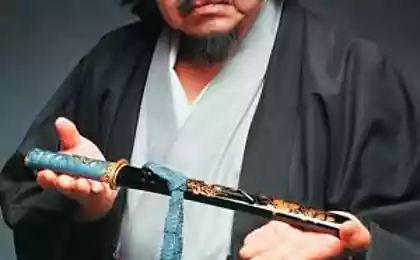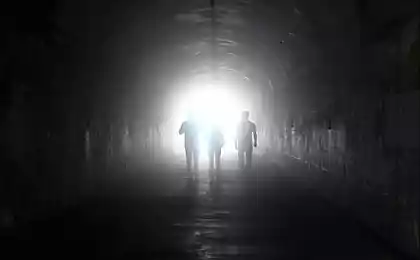1337
Blade of the god of death ...
© Dmitry Samoilov
"Qatar (or dzhamadhar) refers to jog knives, also called tychkovymi or knives Fisted grip. The very name of this weapon means "sword god of death" or "the language of the god of death." They met in China, Indonesia, in Europe, but the most widely used in India.
[NEXT]
selection does not break many pictures I can not say yet. a lot of.
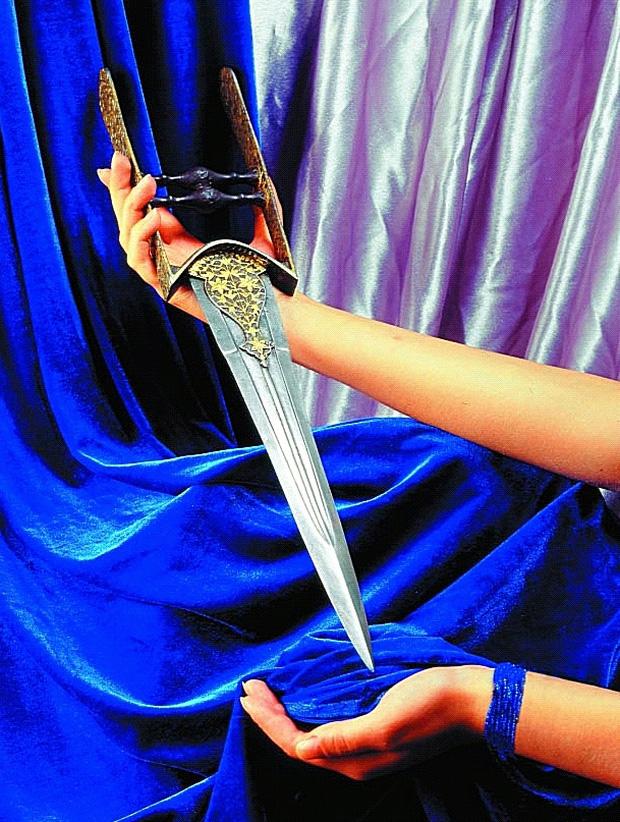
-
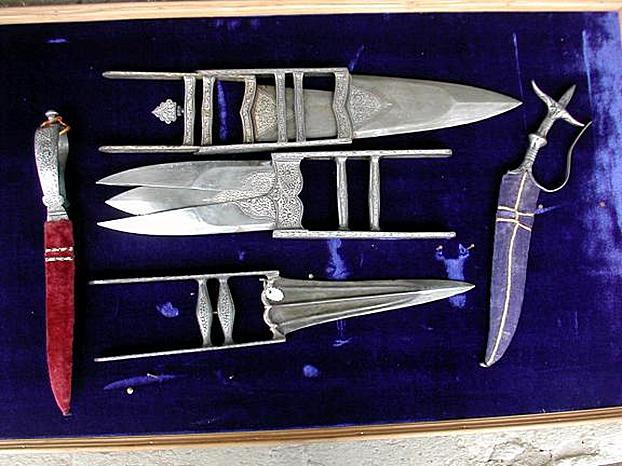
The heyday of the "era" of Qatar accounted for 16-18 cc., Although they appeared much earlier. Even in the 14th century. Arab traveler Ibn Battuta described as one of the scenes, uvidennyhim in India: "The villagers surrounded him, and one of them hit him thrust via Qatar. So called iron weapons, resembling Ploughshares; the hand is inserted into it so that the forearm is protected; Blade is an extension of the hand and has a length of two cubits (that is about 900 mm), and the impact that lethal weapons. " Qatar is mainly used for stabbing. Blade in the form of an isosceles triangle with a wide base provides a highly striking effect. This blade is capable of applying severe stab wounds, which led (at least!) To a rapid loss of blood; such wounds do not close, and hold their hand was impossible. Most often, the blade of Qatar had an isosceles triangle,

although there are other forms of Qatar on the blade, and even with multiple blades.

Blade length can vary within a wide range from 10 centimeters to a meter or more.
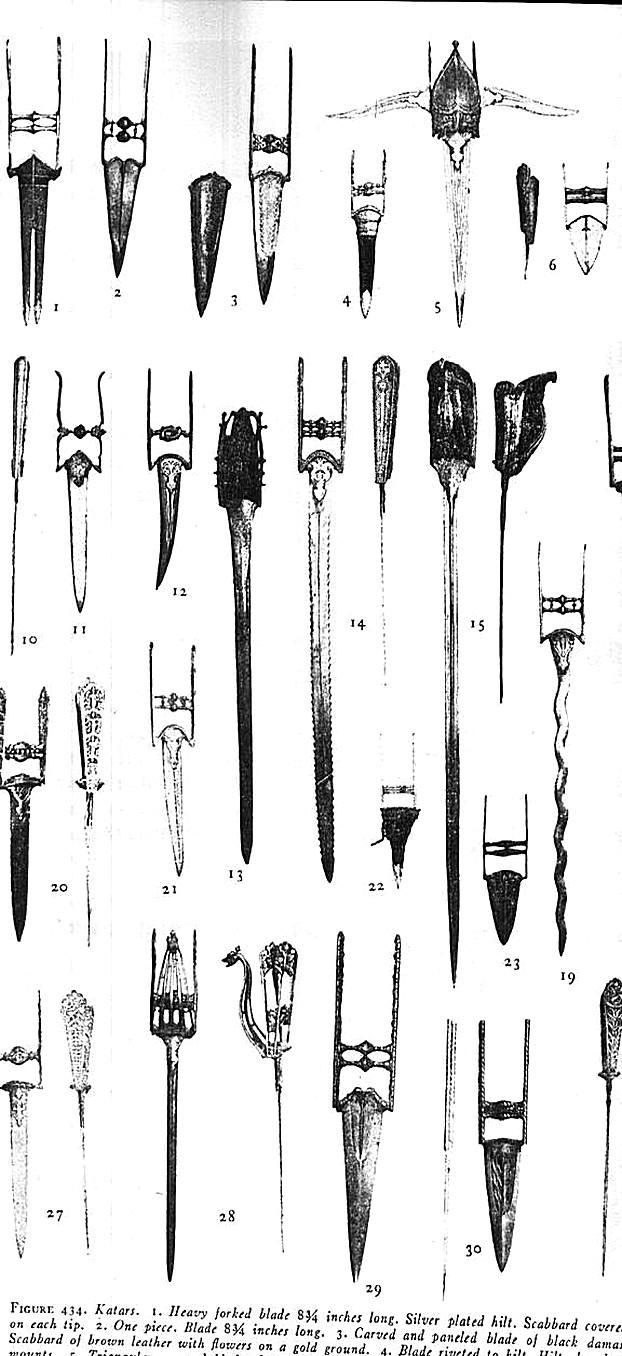
Typically, diamond-shaped cross-section blade, typical of stabbing weapons. From the base of the blade moving away two plates (rarely two rods), walking along the forearm. They are either parallel or diverge at a slight angle. At a certain distance from the blade, these plates are connected by two cross members that act as a handle. Sides performs several functions. First, they are to some extent protect the wrist and could be used to parry opponent's weapon. Secondly, in conjunction with the bracers or other protective equipment such as construction they form the tire are superimposed on a hand fracture, thereby further limiting the mobility of the wrist and making a bunch of hand-guns tougher. Qatar is held not by the force of compression fingers, as in the case of weapons with the traditional arm: fingers lock the handle in his hand, forming a rigid mechanical structure. Reliable retention of Qatar will not decrease, even if the hand and the handle are wet.
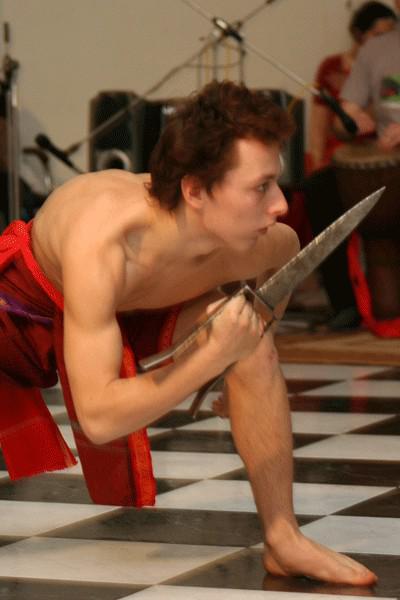
Compared to conventional suspension arm at the wrist joint is significantly reduced, due to its mobility as a limitation, and the load carrying direction. The blade has the same direction with the forearm, providing maximum investment of force thrust. The handle is actually based on the base of the palm. This is particularly important in contact with a solid blow to the target (or bone armor), as it allows virtually painless and absolutely reliably absorb the impact. In the case of a dagger hilt with normal reaction force falls mainly on the rather weak muscles and bones of the fingers. The handle is formed by two cross-members, the most common, although there are some samples of the handle and more cross members. This design solves one of the major problems encountered in holding jog knives, namely, rotation of the handle in his fist under the influence of a force directed to the plane of the blade. In rare specimens of Qatar with a handle in the form of a cross, this problem is solved by a large thickening (in the form of plates), placed in the middle of the handle.
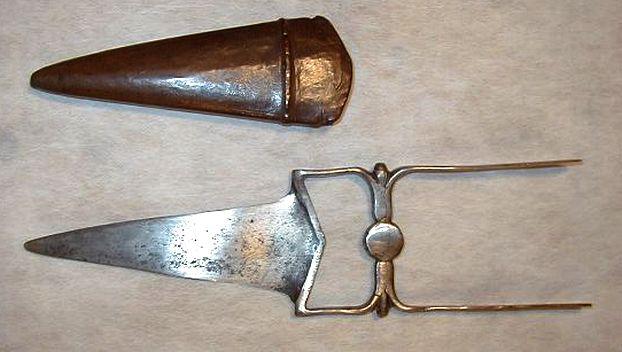
In addition, handle such structures usually has secheniine not a circle and an oval. Specific thickening in the middle of the handle reminiscent of traditional Nepalese knives khukri. This thickening is to prevent longitudinal movement of the hand on the handle. Occasionally there Cathars made in southern India, which are designed to handle the winding rope, but most models do not require a "revision". We know that sometimes before the fight Qatar tied to the arm. The collection of Indian museums have Cathars with special straps for fastening to the arm, and the Cathars with the holes in the handle for the passage of the rope.

Tying served not only as a symbol of the fight until death or victory, but also a good method to prevent the loss of weapons in a protracted battle: reliable retention of Qatar tied to his hand, virtually independent of the degree of fatigue of a warrior. The ability to deliver powerful impact, including on hard targets, caused by the fact that many samples of the Cathars made as a weapon to pierce chainmail. Such "armor-piercing" Cathars have a characteristic thickening of the blade near the tip, providing additional hardening of the most loaded in the prick site.

As already noted, the design features of Qatar determine its amazing properties in thrust. However, chopping and sweeping attack them ineffective. Some species of Qatar were established with the obvious intention to compensate for this disadvantage, such as catarrh with a curved blade.

This design certainly increases the cutting properties of weapons, but due to withdrawal of the tip from the axis of the blade there is a significant loss of efficiency thrust. Another embodiment provides the use of a blade with a special cutting geometry. Some Cathars have serrated edge like the European Flamberge or Malay kris.
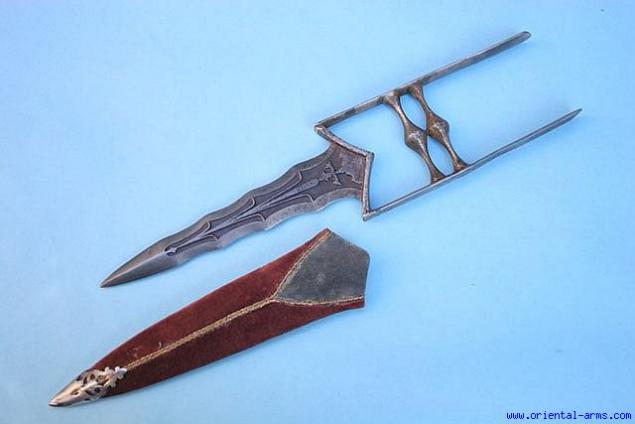
-
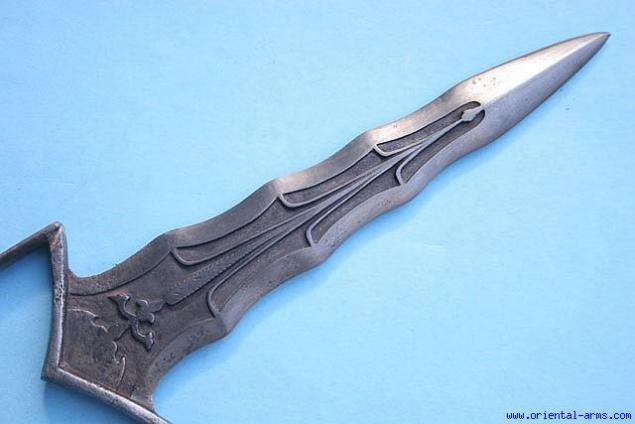
Others - blade with a double bend, shaped like a scimitar, or traditional Indian dagger "bichva." There are also Cathars, the cutting edge of which consists of a set of sharpened semicircular recesses, strikingly resembles modern serreytornuyu sharpening knives.
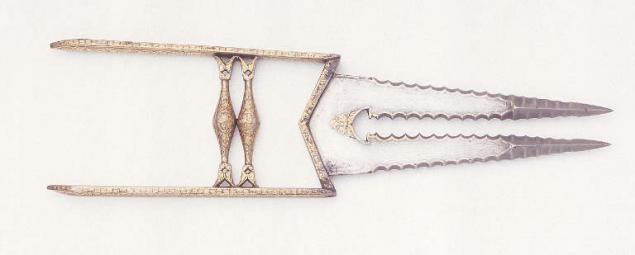
It is interesting to drop Qatar "dzhamadhar selikani", which means "having three blades." The design feature of this type is a special mechanism is actuated by squeezing crosspieces forming the handle.

The mechanism opens the blade into two halves, which diverge at an angle of scissors, so English literature is such a design called "Qatar Scissorhands» (scissors-katar). This opens the third blade, whose hollow halves of the main blade in the retracted position is a foot.
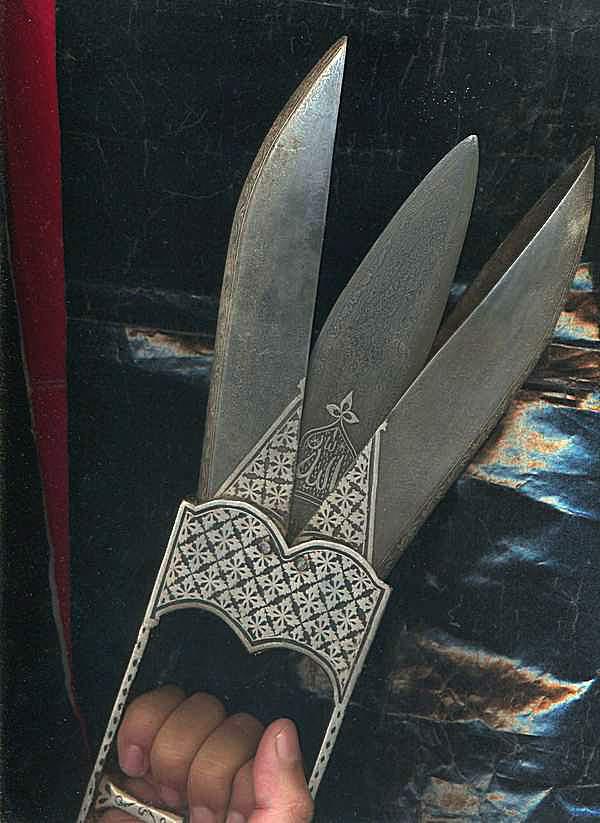
And there is this kind of far in a single copy. Central blade is usually too short for it to be used. The halves of the main blade are too thick due to the fact that in the folded position must hold a central blade. As a result of this folding Qatar practically unsuitable for stabbing. There are no clear historical evidence, describing the method of using such a catarrh, no. One hypothesis (vyskazyvaemayai in domestic and foreign literature) is such that catarrh opened within the opponent's body, greatly increasing the striking effect. It is believed in such difficult because the force required for opening of Qatar, is very significant. It is easy to imagine how it will increase if Qatar would be absorbed into the human body. Moreover, the mechanism of Qatar has a return spring, folding halves of the blade as soon as the pressure on the handle will be removed.
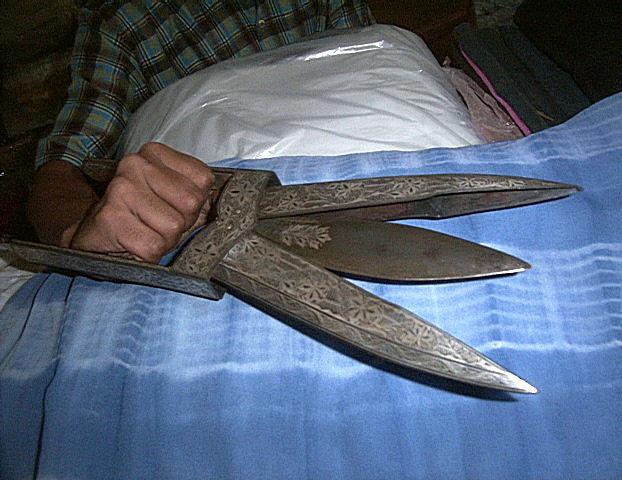
Another hypothesis is more compelling. According to her, "dzhamadhar selikani" is an analogue of the European drop-dagger "shpringklinge Dagh". Such a dagger held in the left hand and the right moment, revealing it was converted into a trap for the enemy's blade. Of course, we are not talking about how to break the enemy's sword or snatch weapons out of the hands. This trap is intended primarily to delay the return of the blade of the enemy, creating a favorable momentdlya attack the main weapons in his right hand.

The manuscript Abul Fazl Allami Cathars referred to several sharp, designed for maximum damage when striking.
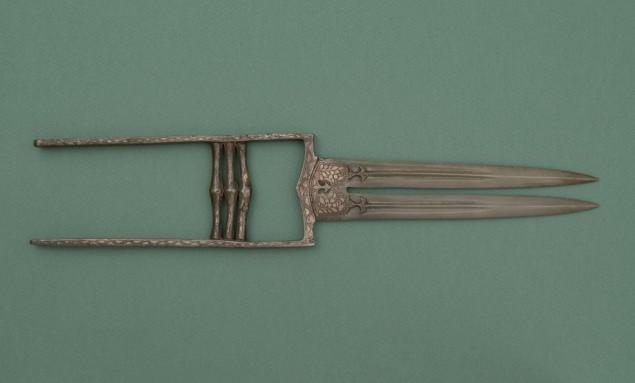
A significant number of these samples represented in various collections, says that this design was quite common. The literature describes another kind of catarrh with three blades. This weapon is in fact Qatar and two daggers held direct and reverse grip. The main blade has a traditional triangular shape, and the two sides resemble Indian daggers bichva and directed almost perpendicular to the main.

In the 16-17 centuries. in Tanzhore, Mysore, and a number of other districts in the south of India, the Cathars were extended with an additional shield to protect the brush handle compression. They are known as "beradzhamdeda," that is "bringing death."
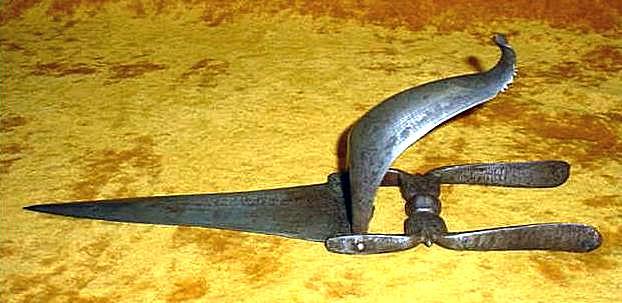
-

Shield often had the shape of a cobra with a swollen kapyushonom.Inogda plate was covered with openwork holes like Gard Portuguese rapiers. Typically, such a catarrh used as a primary weapon in conjunction with protective gloves or armor, a capping arm from the wrist to the elbow; to the left while holding a round shield. Many experts are of the opinion that these are the Cathars long blade and brush were developed protection intermediary evolution of Qatar into a sword "stalemate."
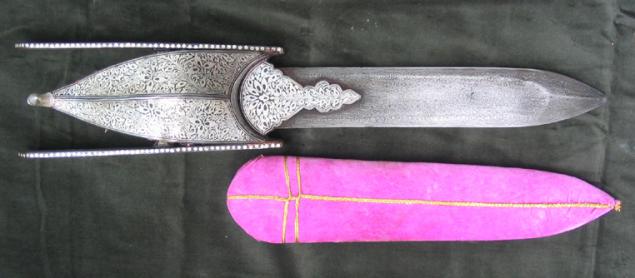
-

-

Many Cathars in the 16th century. fabricated as a monolithic structure in which the blade and the handle comprise one piece.
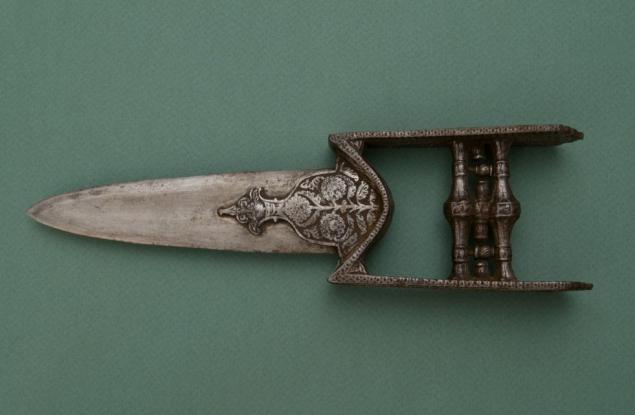
In the later samples are usually fastened to the blade via the handle of the rivet connection.
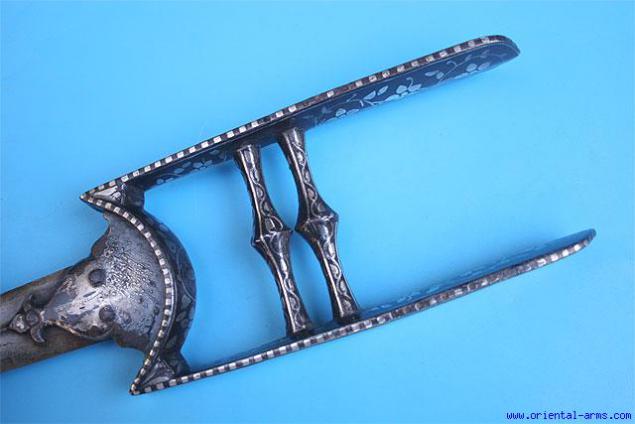
-
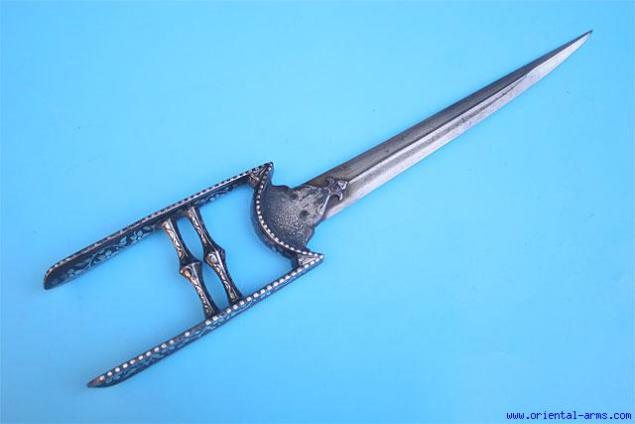
Additional rigidity give special blade longitudinal ribs. The grooves on the blade of Qatar to perform a variety of functions. Firstly, they can facilitate the design, and secondly, the use of the grooves (in case of manufacturing by forging) allows smith redistribute material and making the blade wider at the base, using a small amount of metal. Third, by using the grooves, portions of the blade will have a different thickness and therefore different to warm up and cool down during thermal treatment. Ultimately, this will lead to the emergence of various sections of the blade system of multidirectional stresses, thereby increasing its strength properties.
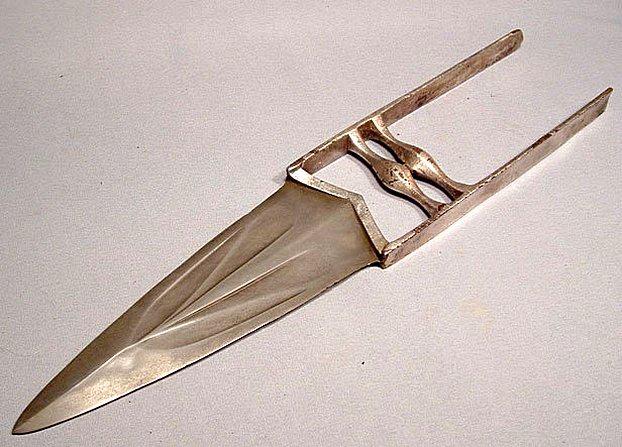
-

-

For the manufacture of blades of Qatar has traditionally been used Indian damask (Damascus cast) or vutts.
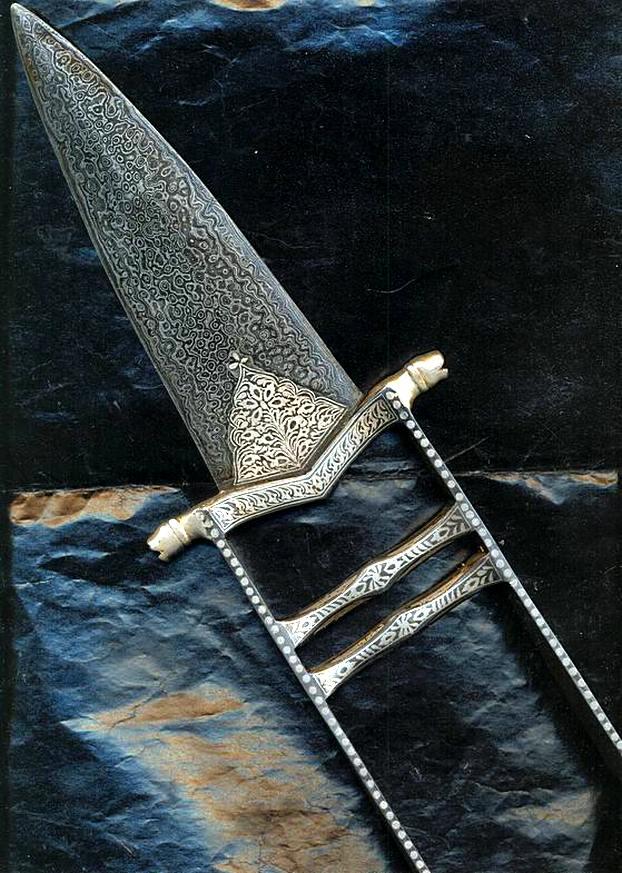
The carbon content therein 1 to 52%. This material is a metal composite in which a soft iron matrix are "fibers" are formed by clusters of very hard spherical grains of iron carbide (cementite). Because of its unique structure, vutts combines two properties, according to the industry opposed, hardness and toughness. Grains cementite leaving the surface of the cutting edge formed at the micro saw or, in other words, a kind of mikroserreytor. This ensures outstanding cutting properties of the blades vuttsa.
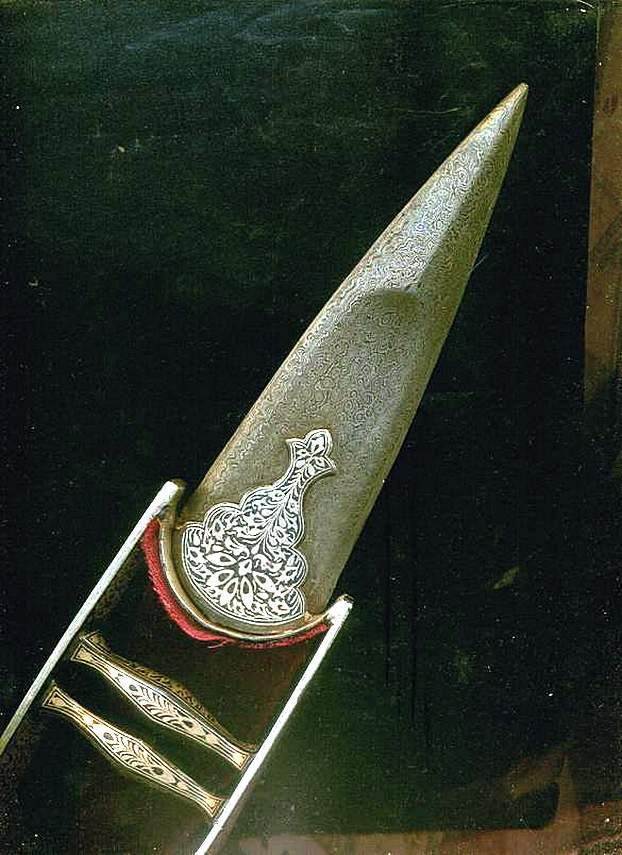
Traditional production technology vuttsa was lost in the middle of the 18th century. Numerous studies have allowed to recover only a general sequence of actions and explain it in terms of modern science. For the first time in Europe metal composite, the chemical composition and structure similar vuttsu was prepared in 19 century. Russian metallurgist PP Anosov, but the technology employed them was fused iron with graphite and different from the one that the descriptions used by Indians. It is known that there are several methods Indians manufacturing vuttsa: directly from iron ore and iron. In an earthen vessel (crucible) fit iron (or two types of iron or iron ore), leaves, glass, charcoal, and possibly a number of components. The vessel was plastered with clay mixed with rice husks. Then it was heated, which lasted several days. In the process of heating the glass is melted to form a flux linking toxins and prevents the iron from oxidation. Leaves isolated by heating the hydrogen, which accelerates the process of carburizing iron. The crucible was organized cyclical process in which the iron is absorbed carbon, which reduces its melting point and, in turn, allowed to absorb carbon next portion. Thanks to the accurate calculation of the time, the Indian masters could stop the process at the moment when the molten iron with a high content of carbon floating small pieces of low-carbon iron. Cool and break the crucible, he received a master ingot vuttsa.
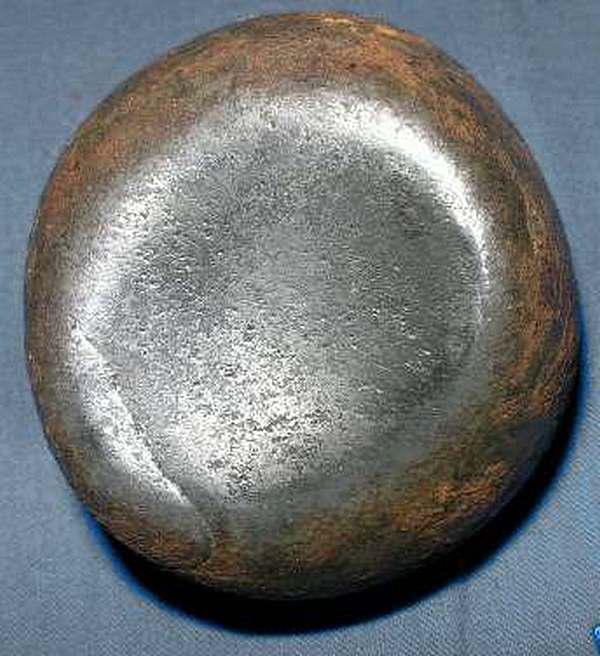
There followed a process of forging and heat treatment of the blade.
The final stage was polishing and etching the surface of the blade using the composition of the fish bile, palm resin, goat and horse milk. As a result of the fact that areas with different carbon content differently amenable to polishing and miscellaneous herbs, appeared on the surface pattern of bright lines corresponding to the fibers of cementite, on a dark background.
The whole sequence of fabrication from beginning to end saturated items deviation from which would lead to failure of the process. Firstly, it is extremely important components: the crucible is required for a special kind of clay, use the leaves of certain plants, coal must also be obtained from a particular type of wood. It was found that the iron ore must contain impurities of vanadium or molybdenum, which are the basis for the formation of clusters of particles of cementite. Second, an accurate control of the temperature and duration of all stages of the process. Third, it plays the role of what the blade to cool by quenching, as well as the way in which section of the blade begins to sink into the cooling composition. On the phenomenal capabilities of steel blades vutts legends attributing such blades ability to cut a single blow and body armor underneath, to cut the stones, cut thrown in vozduhshelkovy handkerchief, bent almost in the ring and then straightened without harm to himself. All these great characteristics based on physical phenomena, which are devoted to the study of many of the works of Russian and foreign scientists. For example, in the works and V.P.Borzunova VA Shcherbakova is given a very detailed explanation of the nature of exceptional properties vuttsa. Of course, speaking of vuttse, we must remember that we are talking primarily about manufacturing technology, not about a particular grade of steel with certain standard features. Obviously, vutts smelted different masters, can vary greatly in quality and properties.
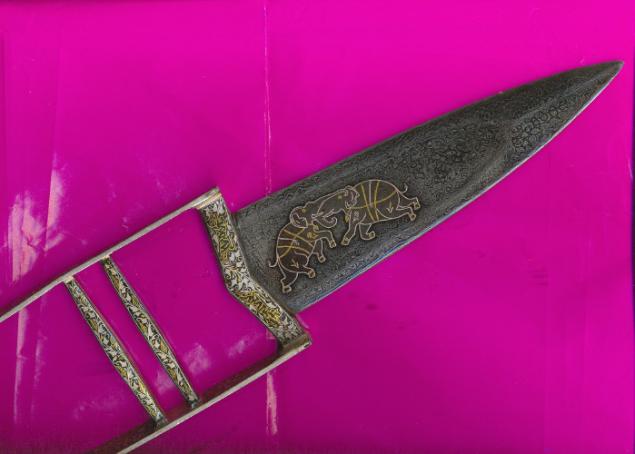
There Cathars alloy vutts whose tip is made of steel and the other is welded to the main blade. In any case, if it's done on the original plan, or as a result of repairs, it is said that the properties of the steel vutts used for the manufacture of the Cathars, proved inadequate to the task at hand.
Many Cathars made in 16-18 centuries., Use swords European swords and rapiers. Such blades in India called "Ferengi" (foreign). For example, Qatar collection Tanjore Palace Armoury is a brand on the blade of the famous Italian master of the 16th century. André Ferrara (Andrea Ferara). Qatar also has another blade from the European sword.

These are most common in the Cathars principalities, were leading an active trade with Europe. They are buying up mostly broken or unusable swords and rapiers, which is part of the blade and went to the manufacturing of Qatar. Qatar, an employee for another sheath of Qatar, a rare variety of weapons. In a number of preserved examples of Qatar, the sheath is of little use for the intended purpose due to the lack of a rounded tip and blades.
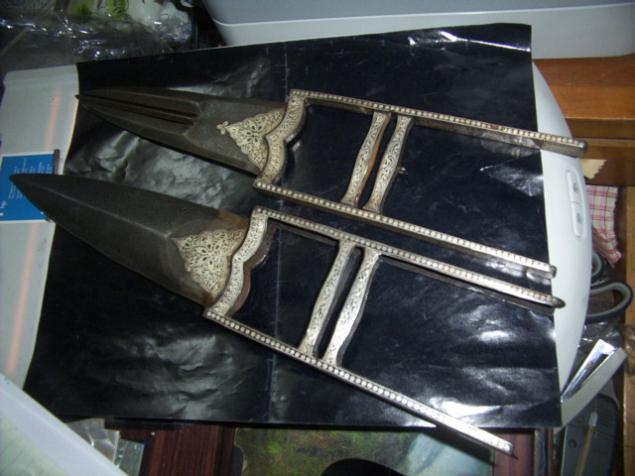
-

-
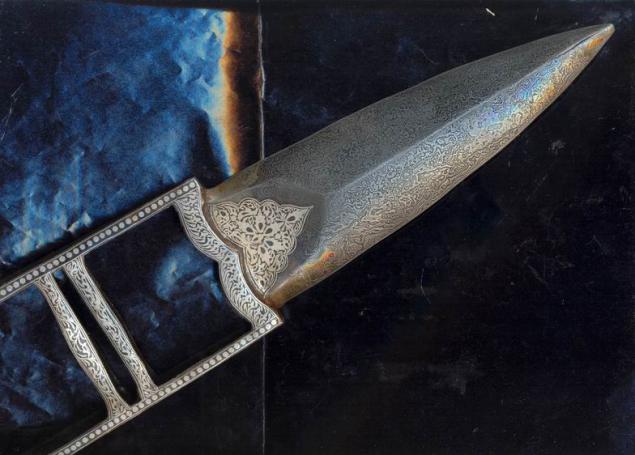
One of the hypotheses of the application of Qatar is based on the potential for dispensing lethal effects. With the help of Qatar sheath could cause accented beats, not resulting in death, and in case of escalation of the situation to extract and use a sharp invested Qatar. Something like the concept underlying the jackknife Gunting firm Spyderco.
Some of the Cathars in 17-18. decorated with scenes of hunting tigers.
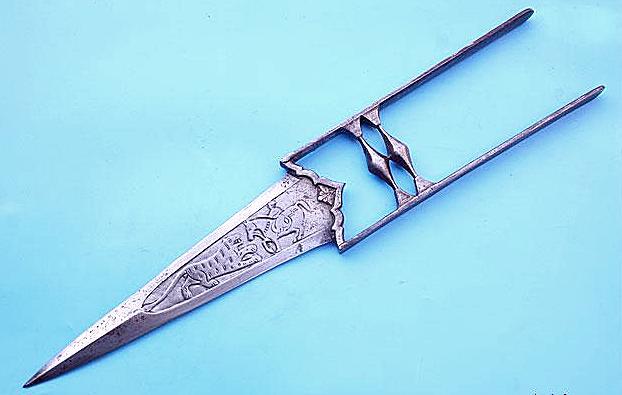
-
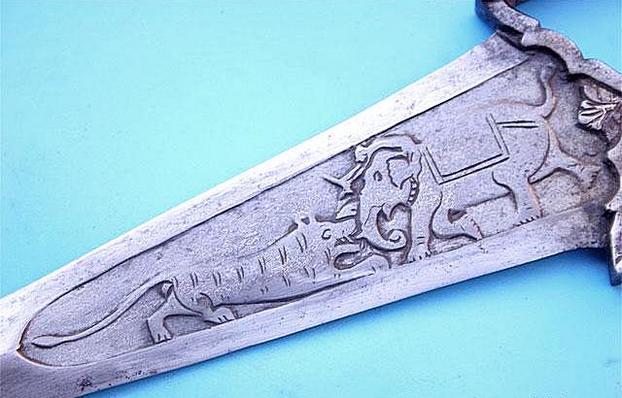
In a number of paintings and illustrations to the books of the time present in Qatar outfit hunters, and one even used against the Tiger (he protected the wounded man fell from the saddle). All this was the reason for the erroneous assertion that the main purpose of Qatar is to apply finishing moves a wounded tiger, though obviously much more reasonable for such a purpose to use a spear, or other weapon with a safe distance. Despite the improbability of the hunting hypothesis in some directories antiquarians Qatar held as "a dagger to hunt tigers».
-
-
-
-
-
-
-
-
-
-
-
-
-
-
-
-
-
-
-
-
-
-
-
all.
Source:
"Qatar (or dzhamadhar) refers to jog knives, also called tychkovymi or knives Fisted grip. The very name of this weapon means "sword god of death" or "the language of the god of death." They met in China, Indonesia, in Europe, but the most widely used in India.
[NEXT]
selection does not break many pictures I can not say yet. a lot of.

-

The heyday of the "era" of Qatar accounted for 16-18 cc., Although they appeared much earlier. Even in the 14th century. Arab traveler Ibn Battuta described as one of the scenes, uvidennyhim in India: "The villagers surrounded him, and one of them hit him thrust via Qatar. So called iron weapons, resembling Ploughshares; the hand is inserted into it so that the forearm is protected; Blade is an extension of the hand and has a length of two cubits (that is about 900 mm), and the impact that lethal weapons. " Qatar is mainly used for stabbing. Blade in the form of an isosceles triangle with a wide base provides a highly striking effect. This blade is capable of applying severe stab wounds, which led (at least!) To a rapid loss of blood; such wounds do not close, and hold their hand was impossible. Most often, the blade of Qatar had an isosceles triangle,

although there are other forms of Qatar on the blade, and even with multiple blades.

Blade length can vary within a wide range from 10 centimeters to a meter or more.

Typically, diamond-shaped cross-section blade, typical of stabbing weapons. From the base of the blade moving away two plates (rarely two rods), walking along the forearm. They are either parallel or diverge at a slight angle. At a certain distance from the blade, these plates are connected by two cross members that act as a handle. Sides performs several functions. First, they are to some extent protect the wrist and could be used to parry opponent's weapon. Secondly, in conjunction with the bracers or other protective equipment such as construction they form the tire are superimposed on a hand fracture, thereby further limiting the mobility of the wrist and making a bunch of hand-guns tougher. Qatar is held not by the force of compression fingers, as in the case of weapons with the traditional arm: fingers lock the handle in his hand, forming a rigid mechanical structure. Reliable retention of Qatar will not decrease, even if the hand and the handle are wet.

Compared to conventional suspension arm at the wrist joint is significantly reduced, due to its mobility as a limitation, and the load carrying direction. The blade has the same direction with the forearm, providing maximum investment of force thrust. The handle is actually based on the base of the palm. This is particularly important in contact with a solid blow to the target (or bone armor), as it allows virtually painless and absolutely reliably absorb the impact. In the case of a dagger hilt with normal reaction force falls mainly on the rather weak muscles and bones of the fingers. The handle is formed by two cross-members, the most common, although there are some samples of the handle and more cross members. This design solves one of the major problems encountered in holding jog knives, namely, rotation of the handle in his fist under the influence of a force directed to the plane of the blade. In rare specimens of Qatar with a handle in the form of a cross, this problem is solved by a large thickening (in the form of plates), placed in the middle of the handle.

In addition, handle such structures usually has secheniine not a circle and an oval. Specific thickening in the middle of the handle reminiscent of traditional Nepalese knives khukri. This thickening is to prevent longitudinal movement of the hand on the handle. Occasionally there Cathars made in southern India, which are designed to handle the winding rope, but most models do not require a "revision". We know that sometimes before the fight Qatar tied to the arm. The collection of Indian museums have Cathars with special straps for fastening to the arm, and the Cathars with the holes in the handle for the passage of the rope.

Tying served not only as a symbol of the fight until death or victory, but also a good method to prevent the loss of weapons in a protracted battle: reliable retention of Qatar tied to his hand, virtually independent of the degree of fatigue of a warrior. The ability to deliver powerful impact, including on hard targets, caused by the fact that many samples of the Cathars made as a weapon to pierce chainmail. Such "armor-piercing" Cathars have a characteristic thickening of the blade near the tip, providing additional hardening of the most loaded in the prick site.

As already noted, the design features of Qatar determine its amazing properties in thrust. However, chopping and sweeping attack them ineffective. Some species of Qatar were established with the obvious intention to compensate for this disadvantage, such as catarrh with a curved blade.

This design certainly increases the cutting properties of weapons, but due to withdrawal of the tip from the axis of the blade there is a significant loss of efficiency thrust. Another embodiment provides the use of a blade with a special cutting geometry. Some Cathars have serrated edge like the European Flamberge or Malay kris.

-

Others - blade with a double bend, shaped like a scimitar, or traditional Indian dagger "bichva." There are also Cathars, the cutting edge of which consists of a set of sharpened semicircular recesses, strikingly resembles modern serreytornuyu sharpening knives.

It is interesting to drop Qatar "dzhamadhar selikani", which means "having three blades." The design feature of this type is a special mechanism is actuated by squeezing crosspieces forming the handle.

The mechanism opens the blade into two halves, which diverge at an angle of scissors, so English literature is such a design called "Qatar Scissorhands» (scissors-katar). This opens the third blade, whose hollow halves of the main blade in the retracted position is a foot.

And there is this kind of far in a single copy. Central blade is usually too short for it to be used. The halves of the main blade are too thick due to the fact that in the folded position must hold a central blade. As a result of this folding Qatar practically unsuitable for stabbing. There are no clear historical evidence, describing the method of using such a catarrh, no. One hypothesis (vyskazyvaemayai in domestic and foreign literature) is such that catarrh opened within the opponent's body, greatly increasing the striking effect. It is believed in such difficult because the force required for opening of Qatar, is very significant. It is easy to imagine how it will increase if Qatar would be absorbed into the human body. Moreover, the mechanism of Qatar has a return spring, folding halves of the blade as soon as the pressure on the handle will be removed.

Another hypothesis is more compelling. According to her, "dzhamadhar selikani" is an analogue of the European drop-dagger "shpringklinge Dagh". Such a dagger held in the left hand and the right moment, revealing it was converted into a trap for the enemy's blade. Of course, we are not talking about how to break the enemy's sword or snatch weapons out of the hands. This trap is intended primarily to delay the return of the blade of the enemy, creating a favorable momentdlya attack the main weapons in his right hand.

The manuscript Abul Fazl Allami Cathars referred to several sharp, designed for maximum damage when striking.

A significant number of these samples represented in various collections, says that this design was quite common. The literature describes another kind of catarrh with three blades. This weapon is in fact Qatar and two daggers held direct and reverse grip. The main blade has a traditional triangular shape, and the two sides resemble Indian daggers bichva and directed almost perpendicular to the main.

In the 16-17 centuries. in Tanzhore, Mysore, and a number of other districts in the south of India, the Cathars were extended with an additional shield to protect the brush handle compression. They are known as "beradzhamdeda," that is "bringing death."

-

Shield often had the shape of a cobra with a swollen kapyushonom.Inogda plate was covered with openwork holes like Gard Portuguese rapiers. Typically, such a catarrh used as a primary weapon in conjunction with protective gloves or armor, a capping arm from the wrist to the elbow; to the left while holding a round shield. Many experts are of the opinion that these are the Cathars long blade and brush were developed protection intermediary evolution of Qatar into a sword "stalemate."

-

-

Many Cathars in the 16th century. fabricated as a monolithic structure in which the blade and the handle comprise one piece.

In the later samples are usually fastened to the blade via the handle of the rivet connection.

-

Additional rigidity give special blade longitudinal ribs. The grooves on the blade of Qatar to perform a variety of functions. Firstly, they can facilitate the design, and secondly, the use of the grooves (in case of manufacturing by forging) allows smith redistribute material and making the blade wider at the base, using a small amount of metal. Third, by using the grooves, portions of the blade will have a different thickness and therefore different to warm up and cool down during thermal treatment. Ultimately, this will lead to the emergence of various sections of the blade system of multidirectional stresses, thereby increasing its strength properties.

-

-

For the manufacture of blades of Qatar has traditionally been used Indian damask (Damascus cast) or vutts.

The carbon content therein 1 to 52%. This material is a metal composite in which a soft iron matrix are "fibers" are formed by clusters of very hard spherical grains of iron carbide (cementite). Because of its unique structure, vutts combines two properties, according to the industry opposed, hardness and toughness. Grains cementite leaving the surface of the cutting edge formed at the micro saw or, in other words, a kind of mikroserreytor. This ensures outstanding cutting properties of the blades vuttsa.

Traditional production technology vuttsa was lost in the middle of the 18th century. Numerous studies have allowed to recover only a general sequence of actions and explain it in terms of modern science. For the first time in Europe metal composite, the chemical composition and structure similar vuttsu was prepared in 19 century. Russian metallurgist PP Anosov, but the technology employed them was fused iron with graphite and different from the one that the descriptions used by Indians. It is known that there are several methods Indians manufacturing vuttsa: directly from iron ore and iron. In an earthen vessel (crucible) fit iron (or two types of iron or iron ore), leaves, glass, charcoal, and possibly a number of components. The vessel was plastered with clay mixed with rice husks. Then it was heated, which lasted several days. In the process of heating the glass is melted to form a flux linking toxins and prevents the iron from oxidation. Leaves isolated by heating the hydrogen, which accelerates the process of carburizing iron. The crucible was organized cyclical process in which the iron is absorbed carbon, which reduces its melting point and, in turn, allowed to absorb carbon next portion. Thanks to the accurate calculation of the time, the Indian masters could stop the process at the moment when the molten iron with a high content of carbon floating small pieces of low-carbon iron. Cool and break the crucible, he received a master ingot vuttsa.

There followed a process of forging and heat treatment of the blade.
The final stage was polishing and etching the surface of the blade using the composition of the fish bile, palm resin, goat and horse milk. As a result of the fact that areas with different carbon content differently amenable to polishing and miscellaneous herbs, appeared on the surface pattern of bright lines corresponding to the fibers of cementite, on a dark background.
The whole sequence of fabrication from beginning to end saturated items deviation from which would lead to failure of the process. Firstly, it is extremely important components: the crucible is required for a special kind of clay, use the leaves of certain plants, coal must also be obtained from a particular type of wood. It was found that the iron ore must contain impurities of vanadium or molybdenum, which are the basis for the formation of clusters of particles of cementite. Second, an accurate control of the temperature and duration of all stages of the process. Third, it plays the role of what the blade to cool by quenching, as well as the way in which section of the blade begins to sink into the cooling composition. On the phenomenal capabilities of steel blades vutts legends attributing such blades ability to cut a single blow and body armor underneath, to cut the stones, cut thrown in vozduhshelkovy handkerchief, bent almost in the ring and then straightened without harm to himself. All these great characteristics based on physical phenomena, which are devoted to the study of many of the works of Russian and foreign scientists. For example, in the works and V.P.Borzunova VA Shcherbakova is given a very detailed explanation of the nature of exceptional properties vuttsa. Of course, speaking of vuttse, we must remember that we are talking primarily about manufacturing technology, not about a particular grade of steel with certain standard features. Obviously, vutts smelted different masters, can vary greatly in quality and properties.

There Cathars alloy vutts whose tip is made of steel and the other is welded to the main blade. In any case, if it's done on the original plan, or as a result of repairs, it is said that the properties of the steel vutts used for the manufacture of the Cathars, proved inadequate to the task at hand.
Many Cathars made in 16-18 centuries., Use swords European swords and rapiers. Such blades in India called "Ferengi" (foreign). For example, Qatar collection Tanjore Palace Armoury is a brand on the blade of the famous Italian master of the 16th century. André Ferrara (Andrea Ferara). Qatar also has another blade from the European sword.

These are most common in the Cathars principalities, were leading an active trade with Europe. They are buying up mostly broken or unusable swords and rapiers, which is part of the blade and went to the manufacturing of Qatar. Qatar, an employee for another sheath of Qatar, a rare variety of weapons. In a number of preserved examples of Qatar, the sheath is of little use for the intended purpose due to the lack of a rounded tip and blades.

-

-

One of the hypotheses of the application of Qatar is based on the potential for dispensing lethal effects. With the help of Qatar sheath could cause accented beats, not resulting in death, and in case of escalation of the situation to extract and use a sharp invested Qatar. Something like the concept underlying the jackknife Gunting firm Spyderco.
Some of the Cathars in 17-18. decorated with scenes of hunting tigers.

-

In a number of paintings and illustrations to the books of the time present in Qatar outfit hunters, and one even used against the Tiger (he protected the wounded man fell from the saddle). All this was the reason for the erroneous assertion that the main purpose of Qatar is to apply finishing moves a wounded tiger, though obviously much more reasonable for such a purpose to use a spear, or other weapon with a safe distance. Despite the improbability of the hunting hypothesis in some directories antiquarians Qatar held as "a dagger to hunt tigers».
-
-
-
-
-
-
-
-
-
-
-
-
-
-
-
-
-
-
-
-
-
-
-
all.
Source:
